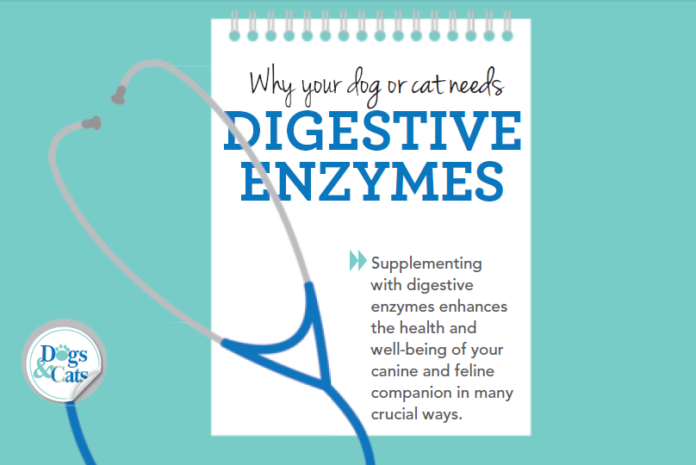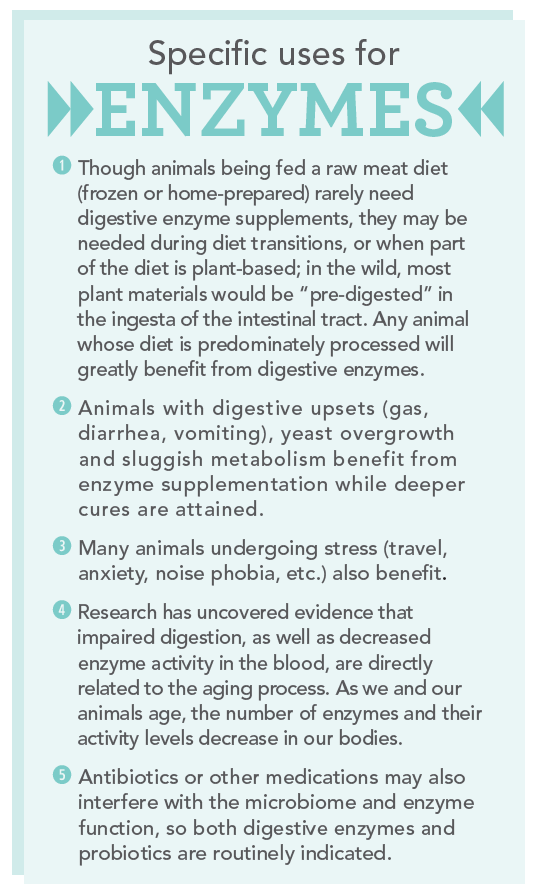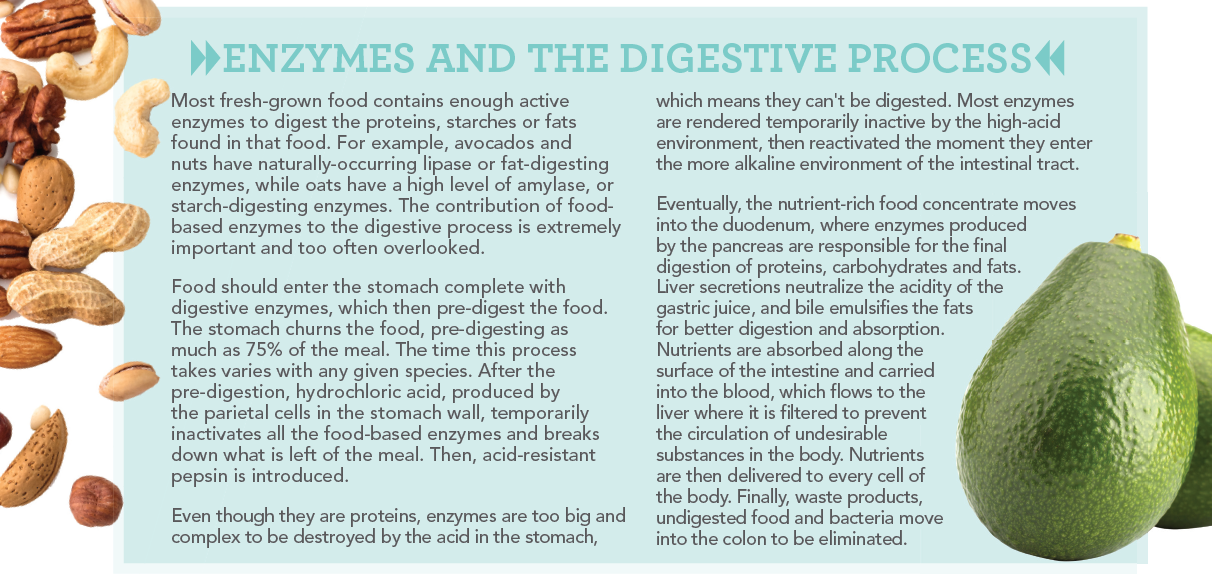Why your dog or cat needs digestive enzymes

Supplementing with digestive enzymes enhances the health and well-being of your canine and feline companion in many crucial ways.
“Man is not nourished by what he swallows, but by what he digests and uses,” wrote Hippocrates. This is true for all creatures, including dogs and cats – and an important part of what determines that nourishment involves digestive enzymes. In this article, we’ll look at what digestive enzymes are, and why they’re so important to your animal’s health.
What is an enzyme?
Enzymes are proteins found either within cells or dissolved in body fluids. They serve as biological catalysts, reducing the amount of energy required for chemical reactions, and controlling metabolic reactions that would otherwise either not take place, or occur very slowly, under normal physiological conditions. There are over 80,000 known enzyme systems, each with a specific function. Life would not exist without them, as the body’s entire metabolic process is based on the activation, inhibition and control of enzymes.
Diseases caused by enzymatic dysfunction
Diseases that disrupt the synthesis or secretion of digestive pancreatic enzymes cause mal-digestion with subsequent malabsorption.
Exocrine pancreatic insufficiency (EPI) occurs when there is a loss of 85% to 90% of exocrine pancreatic mass. Without the pancreatic enzymes, severe mal-digestion and malabsorption of starch, protein and most notably fat will occur. EPI in dogs is often complicated by secondary bowel pathogen overgrowth and antibiotic-responsive diarrhea, which further disrupts nutrient digestion and absorption. EPI is relatively uncommon in cats and is most frequently due to chronic pancreatitis.
Lactase deficiency from a brush border enzyme deficiency may cause milk intolerance in adult dogs and cats. (The brush border refers to the microvilli-covered surface of epithelium cells found in the intestines.)
Amylase deficiency from acquired brush border defects may be seen in the course of generalized small intestinal disease. Carnivores are not suited to high carbohydrate diets, as they cannot maintain long-term production of the quantity of amylase enzymes necessary to properly digest and utilize them. Proteins in grains are also less easily digested than animal proteins. Allergies and other chronic immune problems may develop, as outlined in the next paragraph.
 Allergies and food sensitivities are common with enzymatic dysfunction. Allergens are almost always proteinaceous, and undigested food particles may cross the intestinal barrier into the bloodstream, where they are identified as foreign substances by the immune system. This wastes precious defense resources on a “false alarm” rather than defending the body from true hazards, and is referred to as food leucocytosis (a food-driven increase in white blood cells).
Allergies and food sensitivities are common with enzymatic dysfunction. Allergens are almost always proteinaceous, and undigested food particles may cross the intestinal barrier into the bloodstream, where they are identified as foreign substances by the immune system. This wastes precious defense resources on a “false alarm” rather than defending the body from true hazards, and is referred to as food leucocytosis (a food-driven increase in white blood cells).
CICs (circulating immune complexes) start out as undigested large protein molecules (primarily from wheat, corn, dairy and soy) that can be absorbed into the bloodstream. Antibodies couple with these foreign protein invaders to form CICs. At first, these CICs may be neutralized by the immune system, then eliminated through the lymphatic system and kidneys.
A glut of CICs can overwhelm the body’s ability to eliminate them, so the body is forced to “store” them in its own soft tissues, resulting in an ongoing allergic immune response that leads to inflammation and, ultimately, autoimmune disorders. In fact, studies have shown that diseases which present high CIC levels can be improved or even cured by eliminating the excess CICs. Furthermore, putrefaction in the gut caused by undigested food may jeopardize the integrity of the intestinal wall, allowing various environmental toxins in the food to find their way into the blood and body.

Supplementing with enzymes
Supplemental enzymes are needed to replace those destroyed by cooking and processing food. Processing and cooking at any heat of approximately 118°F to 129°F (48°C to 54°C), for as few as three minutes, can destroy virtually all enzymes. This results in very little pre-digestion taking place in the stomach, which means what’s left of the food mass enters the small intestine largely undigested. This puts the pancreas and other organs of the endocrine system under tremendous stress, since they have to draw reserves from the entire body in order to produce massive amounts of the proper enzymes.
It’s important to consult your veterinarian when selecting the appropriate enzyme product for your dog or cat. Supplemental enzymes are often found in combinations:
- Lipase: Digests most fats.
- Lactase: Digests milk sugar. Most mammals have high intestinal lactase activity at birth, which declines to low levels with age and causes incomplete digestion of milk and other foods containing lactose. Like humans, some dogs and cats seem more capable of tolerating milk than others.
- Amylase: Aids the breakdown and assimilation of starches and carbohydrates so they can be converted by other enzymes to glucose.
- Glucoamylase: Breaks down maltose into glucose molecules.
- Cellulase and hemicellulase: Break down cellulose (fiber), which allows access to key nutrients in fruits and vegetables (e.g. carotenoids in carrots, polyphenols in berries, and folate in beans, spinach and broccoli). Cellulase is produced primarily by fungi, bacteria and protozoans.
- Maltase: Digests complex and simple sugars, as well as unused glycogen in muscle tissue. Glycogen is converted from sugars and starches and is stored in muscle cells for future use.
- Invertase: Breaks down sucrose products like refined sugar, a common food source that can contribute to digestive stress.
- Alpha galactosidase: Helps digest carbohydrates found in certain foods, such as beans, that are not readily digestible in the small intestine. Undigested carbohydrates then pass into the large intestine where they are fermented by bacteria and produce gas, bloating, pain and general discomfort.
As Dr. Edward Howell wrote in Enzyme Nutrition: The Food Enzyme Concept, “A person’s life span is directly related to the exhaustion of their enzyme potential. And the use of food enzymes decreases that rate of exhaustion, and thus, results in a longer, healthier and more vital life.” We can also enhance the lives of our dogs and cats by considering the contribution enzymes make to their wellness and longevity.



